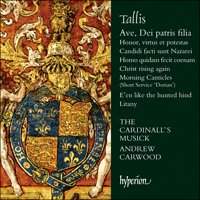Texte paru dans: / Appeared in: |
|
|
Outil de traduction ~ (Très approximatif) |
|
|
Reviewer: J.
F. Weber The fourth disc in the new Tallis series (Fanfare 29:3, 37:4, 37:6) continues this superb rival endeavor to Alistair Dixon’s set of 10 discs on Signum (the ninth is a twofer). Carwood is less inclined to group similar works of a single period on each disc, preferring to compose a varied program each time. This disc, like the first in the series, includes no setting of the Mass, but like that disc it has one of the sprawling (Carwood’s term) early Tudor (or pre-Reformation) anthems as its largest work. The first was the masterly Gaude gloriosa in responsory form, while this disc features Ave, Dei patris filia. This strophic anthem is an early work (the Magnificat a4 on the third disc is the earliest work in all probability), modeled closely on Robert Fayrfax’s setting of the same text. It is a remarkable piece for a young composer, not slavishly imitating Fayrfax’s setting but introducing his own harmonic turns and building toward the end to an impressive climax. On the disc it follows three responsories for Matins or Vespers that belong to the period of Queen Mary’s restoration of Catholic worship, the first two published in the Cantiones Sacrae of 1575. These later works are an advance over the early anthem that follows it, but they fulfill the promise that the composer showed in his early works without returning to the earlier Tudor style.
The rest of the program
consists of music for the Anglican service in Elizabeth’s reign. All except
the Litany are among the Anglican pieces in Dixon’s Volume 6. Only two of
Archbishop Parker’s Psalm Tunes are included. Carwood also included some of
the other Anglican pieces on his second disc. It is hard to appreciate this
austere music after the grand polyphony of the first four works, but the
program is a useful contrast of two aspects of Tallis’s career. Carwood’s
vocal ensemble is about the same size, a dozen or so mixed voices, as
Dixon’s Chapelle du Roi. As in his previous recordings of Byrd and Tallis,
Carwood uses the splendid Fitzalan chapel of Arundel castle, the seat of the
dukes of Norfolk, the highest ranking recusant Catholics of the period (they
succeeded to the Medieval estate when Mary, the last of the FitzAlans,
married the fourth duke of Norfolk). Carwood and Dixon are by no means the
only choices to be had in the music of Tallis; we had a spate of discs from
Jeremy Summerly, Peter Phillips, Harry Christophers, and Andrew Parrott, all
leading vocal ensembles, along with choirs under David Hill and Edward
Higginbottom, as the Fanfare Archive will attest (14:2 compares some of
them). But I find the lovely voices under Carwood simply magical, especially
in the first four tracks. | |
|
|
|
|
Cliquez l'un ou l'autre
bouton pour découvrir bien d'autres critiques de CD |
|




